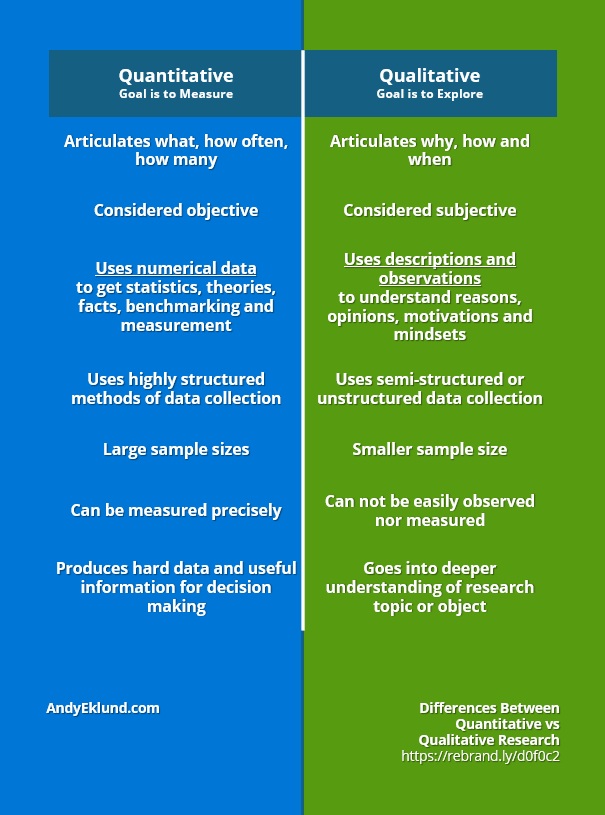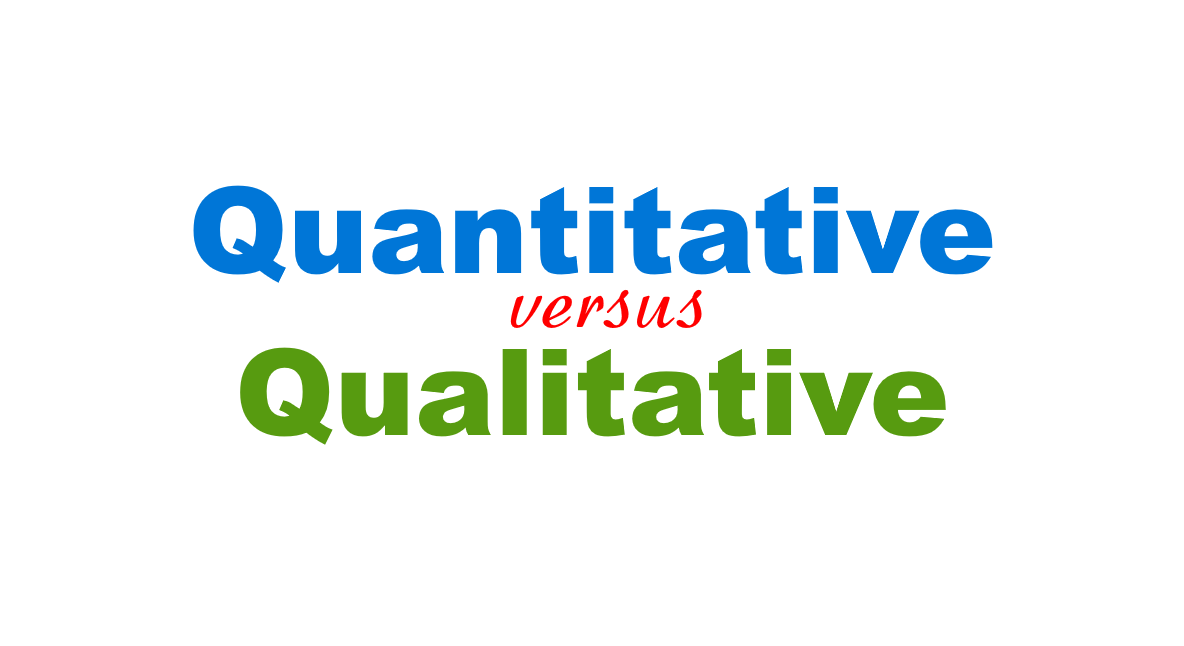If you conduct research, you should know two basic types: quantitative research vs. qualitative research. By understanding the similarities and differences between them, as well as their characteristics and methods, you’ll be more likely to conduct the right type of research to get the right information.
There are three main differences between quantitative and qualitative research:
- Focus
- Quantitative research is focused on numbers and statistics.
- Qualitative research is focused on words and their meaning.
- Characteristics
- Quantitative research is objective and concerned with when and where.
- Qualitative research is subjective and concerned with why and how.
- Methods to gather information
- Quantitative research is used to test or confirm theories or assumptions.
- Qualitative research is used to understand in-depth insights not well understood.

Quantitative Research
Methodical, purposeful collection and investigation of facts in specific situations to:
- Extract unbiased figures
- Create statistics or logic
- Uncover patterns
Based on numbers, either counted or measured.
Its approach is objective, based on exact figures and facts.
Focused on Knowledge
- What … ?
- How often … ?
- How many … ?
Qualitative Research
Methodical, purposeful collection and analysis of non-numerical data through open-ended questions and conversations to understand concepts, opinions, experiences, and potential behaviours.
Based on descriptions and their interpretations, expressed through words and language.
Its approach is subjective, based on characteristics, traits, habits, and emotions.
Focused on Reasoning and Context
- Why … ?
- How … ?
- When … ?
Examples of
Quantitative Research
Questions
How many people visited our website in March?
How often did new employees access their benefits portal in FY24?
How much new business revenue did our agency receive in the last quarter?
Examples of
Qualitative Research
Questions
Why do people visit our website?
How do our factory workers feel about the safety procedures?
When do you prefer to shop online, as opposed to going to the store?
Characteristics of
Quantitative Research
Based on quantitative data
Anything that can be counted or measured. The data is shown in disciplined forms, such as tables, graphs, or charts to help with calculating and analysing.
Gathered through structured tools
Collecting numerical data in ways the precise results can be analysed. See examples of research methods below.
A significant size of the audience
Preferable to have a larger sample size to control risk of false conclusions. The larger the audience, the smaller the margin of error. The more samples, the greater the precision.
Close-ended questions
Closed-ended questions elicit three types of answers: a specific figure, a specific word, or yes/no. These finite answers help to quantify the respondent’s choice, preference, or reaction.
Looking to past research and studies
By looking at previous research, it’s easier to compare and contrast data.
Characteristics of
Qualitative Research
Based on qualitative data
Describes information that cannot be counted or measured, using words, phrases, and labels to express characteristics, traits, qualities or emotions.
Multiple sources
Data comes from a variety of sources to show or demonstrate breadth or different perspectives to describe a whole.
Gathered in person
Relies upon visual cues to see what or how the respondent is behaving at that moment in a real-life environment.
Based on communications and conversation with the audience
Information is gathered face-to-face in open communications, based on rapport and trust. In doing so, the respondent gives their honest, candid thoughts.
Open-ended questions
Open-ended questions allow the broadest possible answers. Respondents can give personalised answers to share their thoughts, opinions, or attitudes.
Methods for Quantitative Research
Surveys and polls
Most common. Closed-ended questions. Implemented either as paper-based, contact through telephone/mobile/cell, stand-alone kiosks, or online.
Interviews
Live, by telephone or online.
Intercepts
Before, during or after a specific experience to rate or judge their engagement, involvement, or opinion.
Live observation or experiments
Involves people doing a task, with a control group and an experimental group for variables.
Review of existing documents
Gathering secondary external and/or internal documents
Methods for Qualitative Research
Live interviews
Most common. 1-on-1 conversations, live, phone or virtual, conducted in real time. Uses open-ended questions. Preferably held in their environment (home, office). Captures both verbal and non-verbal communication cues.
Focus groups
A group of people gathered in a distinct location, guided by a facilitator, where the participants share their opinions and perspectives with each other.
Record keeping or diaries
Participants are asked to record their thoughts or actions, either paper- or web-based.
Ethnographic research
Gathers the most detail by visiting or living with the participants in their environment to study their opinions and behaviours in real-time. Limited by geography. Time-consuming and expensive. Often aligned with customer or user journey mapping.
Pros-Cons of Quantitative Research
Advantages
Quick.
Relatively easy to do, easy to draw conclusions based of specific numbers and facts.
Facts leave little room for misinterpretation.
Easy to replicate, do again to re-prove your conclusions.
Disadvantages
Numbers can’t/don’t explain the full picture.
Limited by how much you can extract.
Not always directional or conclusive.
Results can be affected by different types of bias.
Pros-Cons of Qualitative Research
Advantages
Rich, considerable amount of depth and perspective.
Easier to identify predictive behaviour.
Allows the researchers to build trust and rapport with audience in hopes they share more.
Disadvantages
Can be expensive, depending upon the research method.
Much harder to do, takes longer, not always conclusive results.
Not necessarily statistically accurate.
Wide interpretation, depending upon the researcher.
Results can be affected by different types of bias.
Final Notes
Both types of research have enormous value, but that value can only be determined by the:
- Purpose of the research
- Current situation of the organisation, internally or externally
- Resources available
- Outcome the organisation wants to achieve
Quantitative research is generally more common because it’s easier and faster to conduct. However, on their own, neither quantitative nor qualitative research creates a full picture. Only when the two are combined, with thoughtful consideration of how they complement each other, will you get the most complete overview of your key audiences.
On a related note, here’s an article about specific attributes of quality information in
For more information, check out the Australian Bureau of Statistics on Quantitative and Qualitative Data and Research. Depending upon which country you live, your government would have a similar bureau to provide advice and considerations in local languages.
Content for this article has been gathered from the Australian Bureau of Statistics, Monash University (Melbourne, Victoria, Australia), the National Institute of Health (UK), Northwestern University (Illinois, USA), and Scribbr.com.
For a download of this article, please click here.


No comment yet, add your voice below!